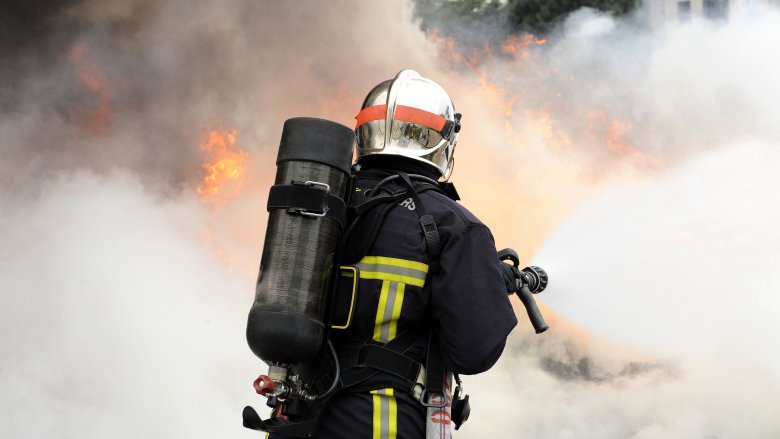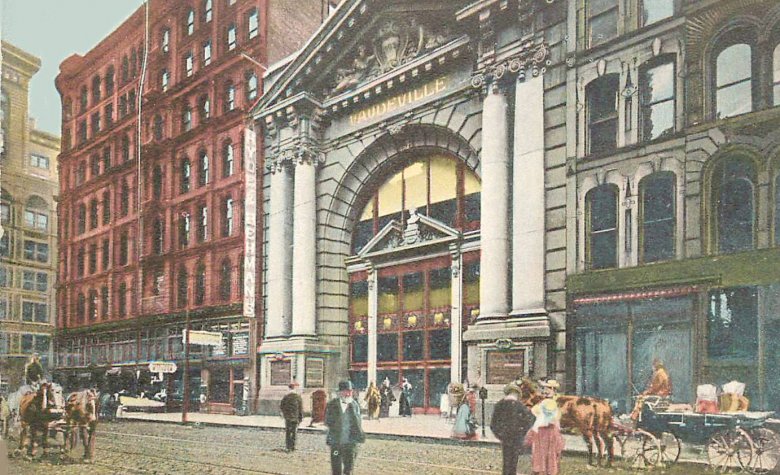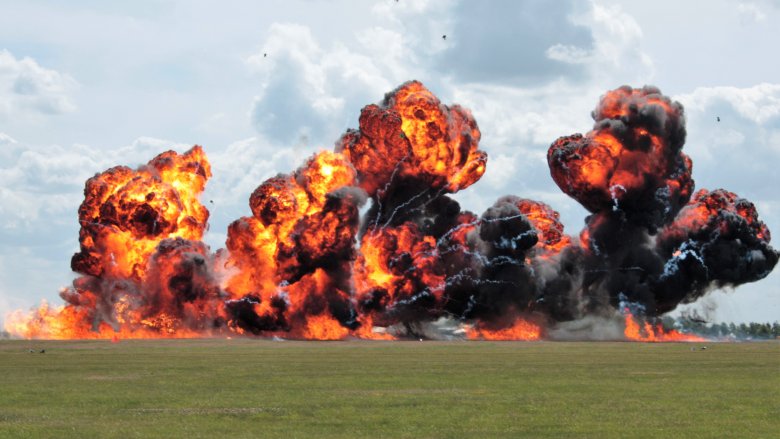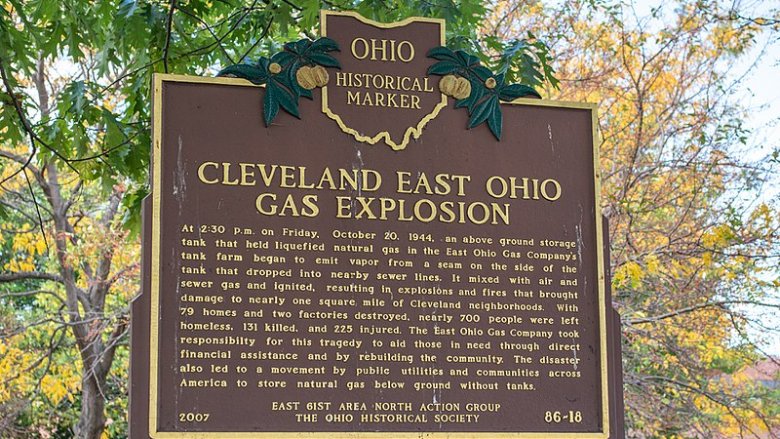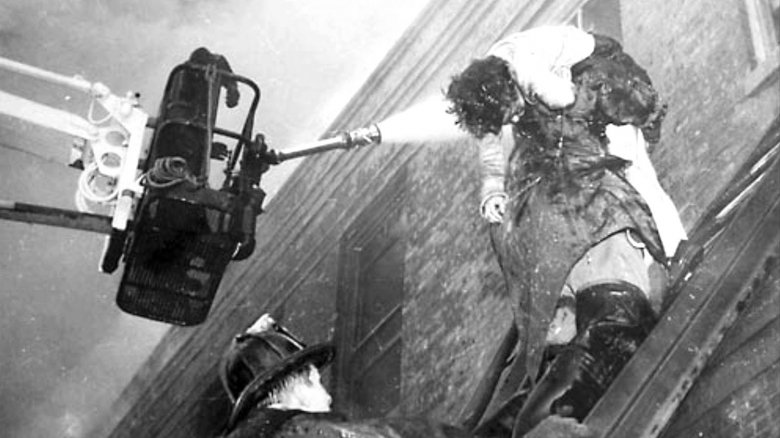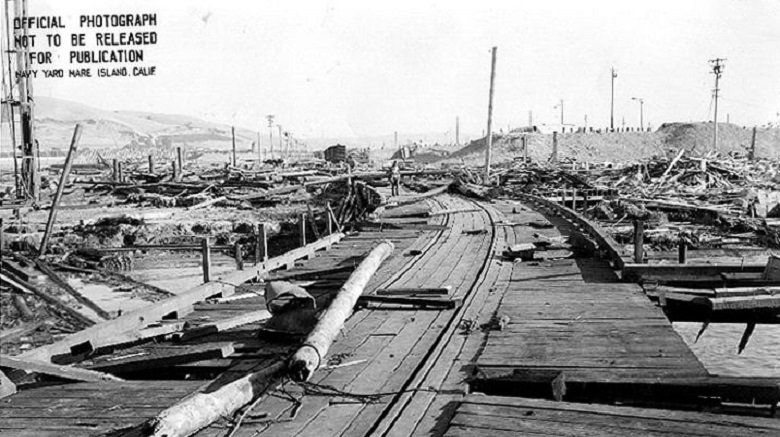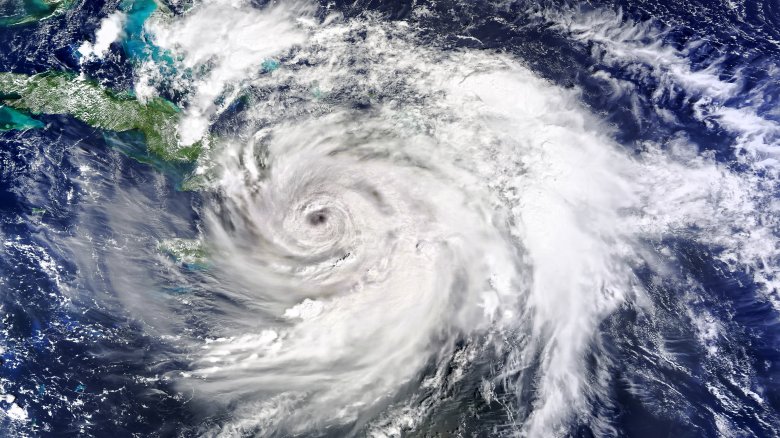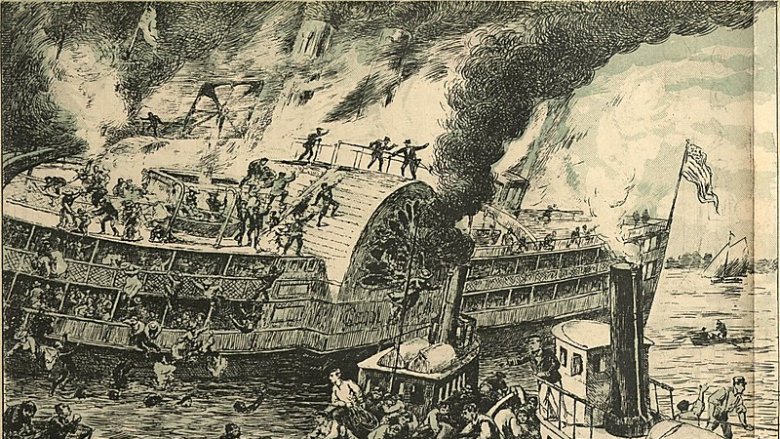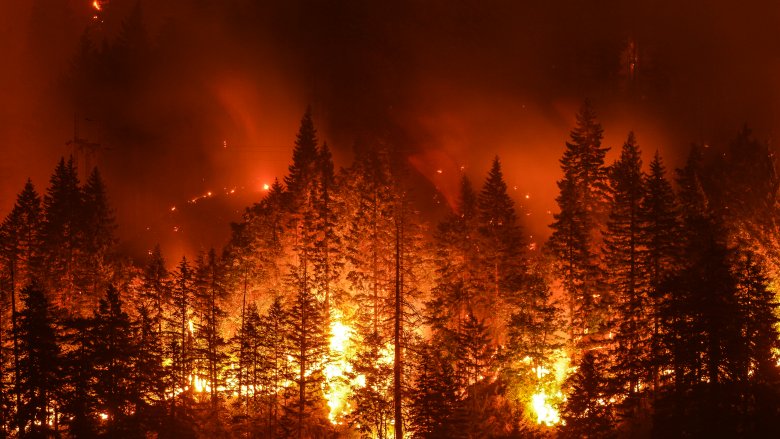The Biggest Disasters In American History You Forgot About
Every now and then, Fate likes to give humans a visceral reminder that we're nothing more than weak little mammals trapped in a world governed by forces beyond our control. Hurricanes, tsunamis, explosions, wildfires ... all occasionally come ripping through our sheltered lives, leaving a very specific lesson about death in their wake. When that lesson is particularly big, the whole of society tends to remember it. Hurricane Katrina, the Challenger disaster, even the 1906 San Francisco earthquake are all still remembered by the average American as awful tragedies.
But not every deadly disaster goes down in history. Sometimes, a cataclysm will strike that kills scores or even hundreds, yet winds up being all but forgotten. Some, like the Peshtigo Fire that occurred on the same day as Chicago's Great Fire, eventually become semi-famous for being obscure. Others remain so obscure that not even aficionados of obscurity remember them. Here are the American disasters that shocked your grandparents but are now almost totally forgotten.
The Iroquois Theater fire sets horrific records
You know that old warning about not shouting "fire" in a crowded theater? There's a very good reason it exists, as anyone who was at the Iroquois Theater in Chicago on December 30, 1903, would testify. That was the day a fire started in the 5-week-old theater during a packed performance of Bluebeard. When people saw the flames, they panicked. The panic became a stampede, which became a crush, which in turn became a disaster. By the time the fire department arrived, 602 people were dead. Ironically, the Iroquois had advertised itself as "absolutely fireproof."
As Smithsonian recounts, the Iroquois Theater disaster remains the deadliest urban fire in U.S. history, even if only a minority of those killed actually died from smoke inhalation. The real dangerous thing that day were the fire exits. Because patrons from the cheap seats had a habit of sneaking down into the good seats mid-performance, the Iroquois' management had barred most exits off. So when a huge fireball ignited, everyone surged for the locked doors and wound up crushing one another. Those lucky enough to find an unlocked door found themselves trapped on a roof with no fire escape. At least two jumped to their deaths.
It was the holiday season, and the majority of those inside the Iroquois were women and children, which galvanized Chicago society. While no one was ever held liable for the blaze, it did at least result in businesses paying attention to fire safety regulations.
New London is still America's worst school disaster
Nowadays, the words "school" and "disaster" sadly bring to mind stories of jerks with guns taking out their jerkiness on others with bullets. Yet the greatest loss of life in an American school has absolutely nothing to do with mass killers, and absolutely everything to do with lax safety procedures. The New London School was meant to be an educational utopia for the children of one of America's wealthiest school districts. It was clean, expensive, and built atop a natural gas line that, unbeknownst to anyone, had leaked, filling the basement odorless fumes. At 3:17 p.m., March 18, 1937, a stray spark ignited the lot.
As Time tells it, the resulting explosion didn't just level the school. It blew shockwaves through the entire community, so loud that workers 4 miles away heard it and came running. Of the 700 pupils and staff inside the school at the time — including a group of 50 mothers watching a recital — somewhere in the region of 300 were killed. Perhaps the saddest part of all was the timing. The last bell was just 13 minutes away from ringing when the gas ignited (via Texas Monthly).
The explosion remains not just America's worst school disaster, but one of the three deadliest incidents to ever happen in a school building outside wartime. Only the 2004 Beslan school siege in Russia (death toll: 334) and the 1995 Dabwali school fire in India (death toll: 442) wound up being deadlier.
Twin gas explosions flatten half of Cleveland
In fall 1944, America's newspapers were filled with tales of the catastrophic death tolls coming from Europe and the Pacific. So it may be understandable that a disaster that left 130 dead got lost beneath the avalanche of headlines concerning thousands killed in battle. But the East Ohio Gas Company explosions weren't minor by any stretch. According to History, the twin blasts "destroyed two entire factories, 79 homes in the surrounding area and more than 200 vehicles." The cost for all this devastation would later be placed at $10 million, equivalent in today's money to a really, really big amount.
At the time, the East Ohio Gas Company stored its natural gas reserves in gigantic metal tanks right in the heart of downtown Cleveland. Unfortunately, the gas was also stored at negative 250 degrees, which made the metal contract over time and, ultimately, split. At 2:30 p.m. on October 20, lab techs noticed white vapor escaping one of the tanks. They had just enough time to poop their pants before it detonated 10 minutes later, sending a plume of fire 2,500 feet into the sky.
The explosion destroyed everything within a half mile, including homes, businesses, schools, and bars. It also caused another gas tank to explode, adding to the destruction. Interviewed in 2014 by Cleveland.com, one eyewitness recalled vanished buildings, roads with craters in them, and burned-out cars scattered across the street. All told, 130 died while another 250 were injured.
Our Lady of the Angels: the worst school massacre in U.S. history?
The Bath School bombing of 1927 is usually credited with being the worst school massacre in U.S. history, killing as many as the Sandy Hook and Parkland shootings combined. But what if there were another contender, a slaughter that potentially killed more than Sandy Hook, Parkland, and the Bath School bombing together? Well, there is, and it's not some obscure event from pioneer days, either. On December 1, 1958, a fire tore through the Our Lady of the Angels Catholic school in Chicago (via Daily Herald). The suspected cause? Arson.
The fire remains the third largest in Chicago history, which is even crazier when you remember that number one is the actual Great Chicago Fire. It started in the basement around 2 p.m. before quickly engulfing the entire building. Thanks to fire safety apparently being a concept people in the past were unfamiliar with, the school had only a single fire exit, no smoke detectors or sprinklers, and was surrounded by an iron fence that was locked shut. Oh, and just about everything was made of wood, meaning the fire spread in double-quick time.
It took 200 firefighters to calm the blaze, which claimed the lives of 92 children and three nuns. It was eventually traced back to a single wastebasket, leading to the official verdict of "suspected arson." That means there could be someone still alive today with the deaths of nearly 100 people on their conscience, and we have no idea who they are.
Port Chicago's disaster kills half as many black servicemen as the Nazis
Military history sites put the number of African-Americans killed in combat in World War II at 708. That's because the 1940s were the good ol' days of institutionalized racism, when the Army was still pretty sure letting black soldiers do anything more than work as cooks or handymen could lead to all sorts of catastrophes. Yet just because they were largely kept away from combat didn't mean black soldiers weren't at risk of dying horribly. On July 17, 1944, an explosion at Port Chicago, California, wiped out 320 lives, mostly black enlisted men. It was one of the biggest single losses of life experienced by the black community during the entire war.
History has the details. That day, untrained men had been forced to load two ships with munitions at high speed, ignoring safety procedures to finish on time. There were roughly 5,000 tons of explosives on the ships and on the pier that evening when, at 10:18 p.m., the inevitable happened. An accident caused all 5,000 tons of ammunition to detonate, and all 320 men working on the ships were killed.
The explosion was powerful enough to shake the ground in Nevada. It also sent shockwaves through the Navy ranks. Not one month later, 258 untrained African-American men mutinied after being ordered to load munitions in circumstances similar to Port Chicago. Fifty of them were court-martialed and given 15 years' hard labor. It wasn't until 1994 that this harsh punishment was recognized as racially motivated.
Hartford Circus fire and the tears of a clown
On the scale of tragic sights, there are few more tragic than a clown crying. When a photographer captured the tears of Weary Willie on July 6, 1944, that was doubly true. Perhaps the biggest star of American clowndom in the mid-20th century, Weary Willie was known for generating laughs tinged with melancholy. On that day, though, there were no laughs to be had. Willie had the misfortune to be in Hartford, Connecticut, when a circus tent housing 7,000 people burst into flames. The blaze lasted 10 minutes, but the memories would haunt the clown for a lifetime.
The Paris Review has the story. It was a hot afternoon and thousands had turned out for a Barnum & Bailey and Ringling Brothers show. Because rain was forecast, the owners of the tent had coated the canvas with a mixture of gasoline and paraffin to waterproof it. Spoiler: It's not rain they should have been worrying about. When a fire broke out, the tent instantly went up. With flaming fabric raining down on them, the audience panicked. There was a stampede for the exits. By the time the inferno burned itself out, 167 people were dead and over 700 injured.
It would have been more if Willie hadn't hoisted up a section of canvas and helped a group to safety. Despite his heroic actions, the clown spent the rest of his life replaying the fire in his head, telling family it was like a movie he "could not turn off."
Puerto Rico's deadly 19th-century hurricane
On April 11, 1899, Puerto Rico was ceded to the U.S., after the Paris Treaty of 1898 was finally ratified. Just under four months later, the new (but still not incorporated) territory was hit by what is regarded as one of the worst hurricanes to ever affect any part of the U.S. Known as San Ciriaco, the Atlantic hurricane was the longest-lived on record. Puerto Rico was deluged beneath torrential rains for 28 days, while winds broke 100 mph. When the downpour finally stopped in September, 3,400 Puerto Ricans were dead and half the island flooded (according to the Library of Congress).
As you'll no doubt be really, really surprised to hear, the response in Washington was kinda lax. Although half the island was in danger of starvation, Congress voted to give no funding for relief efforts. They did allow a popular charity program to spring up, dedicated to letting normal Americans support the Puerto Ricans, but the distribution of those funds was screwy to say the least. History News Network details how politicians were worried this "welfare" could make the islanders naturally lazy, so gave it to the owners of flooded plantations. These owners then ensured the poor could get back into work ... provided they accepted far lower wages than before the storm.
Thankfully, though, everyone involved in the fiasco realized what a disaster the government's own disaster relief had been, and no other hurricane in Puerto Rico's history ever went ignored and its relief mismanaged ever again.
1980's heatwave was deadlier than you remember
In the summer of 1980, the central and eastern states were hit by what can only be called the mother of all heatwaves. A combination of drought and soaring temperatures killed so many crops that agricultural damages were estimated at $20 billion. In Memphis, temperatures ran at over 100° F (37.7° C) for 15 straight days. The official death toll of that baking summer is around 1,700. If you're from one of the states that was hit, chances are your parents or grandparents still remember it.
So, what's such a memorable climate event doing on a list of forgotten disasters? Well, it's not so much that the heatwave itself is forgotten, as the full extent of the damage it did. According to the Homeland Security Digital Library, drawing on data from NOAA, Death didn't stop when his scythe cut down the 1,700th victim. If you include both direct and indirect death, the toll of 1980's heatwave rises to a jaw-dropping 10,000.
Indirect deaths are deaths that aren't caused by the weather itself, but by the conditions it creates. So, in the case of a hurricane, that would include patients who died because their medical equipment got knocked out, or whatever. Whether or not to include indirect deaths in counts is still a topic of debate, but the widely published tolls for Hurricane Maria, for instance, include them. Were similar standards applied to 1980's scorching summer, it could be the deadliest natural disaster in U.S. history.
NYC's worst pre-9/11 disaster wipes out an entire community
It took nearly a century for the General Slocum disaster to be matched in New York City, and that was only when planes slammed into the Twin Towers. Prior to September 11, 2001, no day in NYC history came close to June 15, 1904. That morning, a group of children from Little Germany boarded the steamship General Solcum for an end of school outing. The Smithsonian estimates there were 1,350 people onboard when it cast off into the East River. Less than a quarter of them survived.
At some point in the journey, someone carelessly tossed a smoldering cigarette into a barrel filled with hay. When the crew tried to put out the fire, it turned out their hoses were rotten. Not only that, but the lifesavers were all rotten, too. As fire engulfed the ship, people jumped overboard by the hundreds. Sadly, only a tiny fraction of them could actually swim, and an even smaller fraction of them avoided being dragged to their deaths by non-swimmers. Shockingly, at least one pier where the captain tried to make an emergency landing turned him away. By the time he managed to beach the Slocum, the middle of the ship had collapsed, dropping hundreds more to a painful death in the heart of the inferno.
All told, 1,021 died in the Slocum disaster, nearly all of them children and women from Little Germany. The scale of death devastated the community, leading to its collapse only a couple years later.
The Cloquet-Moose Lake fire wipes out nearly 40 towns
If there's one lesson you should take from reading about all these tragedies annd disasters, it's that you're darn lucky to be alive in a time of strong safety regulations. In 1918, "employee safety" was apparently a synonym for "not giving a single crap about anything." Timber companies operating at the time were in the habit of leaving dry scraps of wood scattered through the highly flammable forests they worked in, and those operating near Sturgeon Lake in Minnesota were even more reckless, storing piles of tinder alongside rail lines that frequently gave off sparks. On October 12, this game of chicken with fiery death ended the only way it could.
October that year had been such a hot, dry month that a Harlequin hero's smoldering gaze alone would've probably been enough to trigger an inferno. In this case, though, a spark from those rail lines was what did it. The blaze quickly turned into a rampaging wildfire that engulfed Moose Lake. As History details, it soon grew to cover an area of 1,500 square miles, consuming nearly 40 towns and villages and hundreds of people.
All in all, somewhere around 450 people died in the fire, including dozens who burned to death while escaping in their cars. There are some estimates that go up to 1,000 deaths. North of 4,000 houses, 40 schools, and 6,000 barns were burned. Remember that the next time someone starts complaining about the government suffocating you under too many safety regulations.
